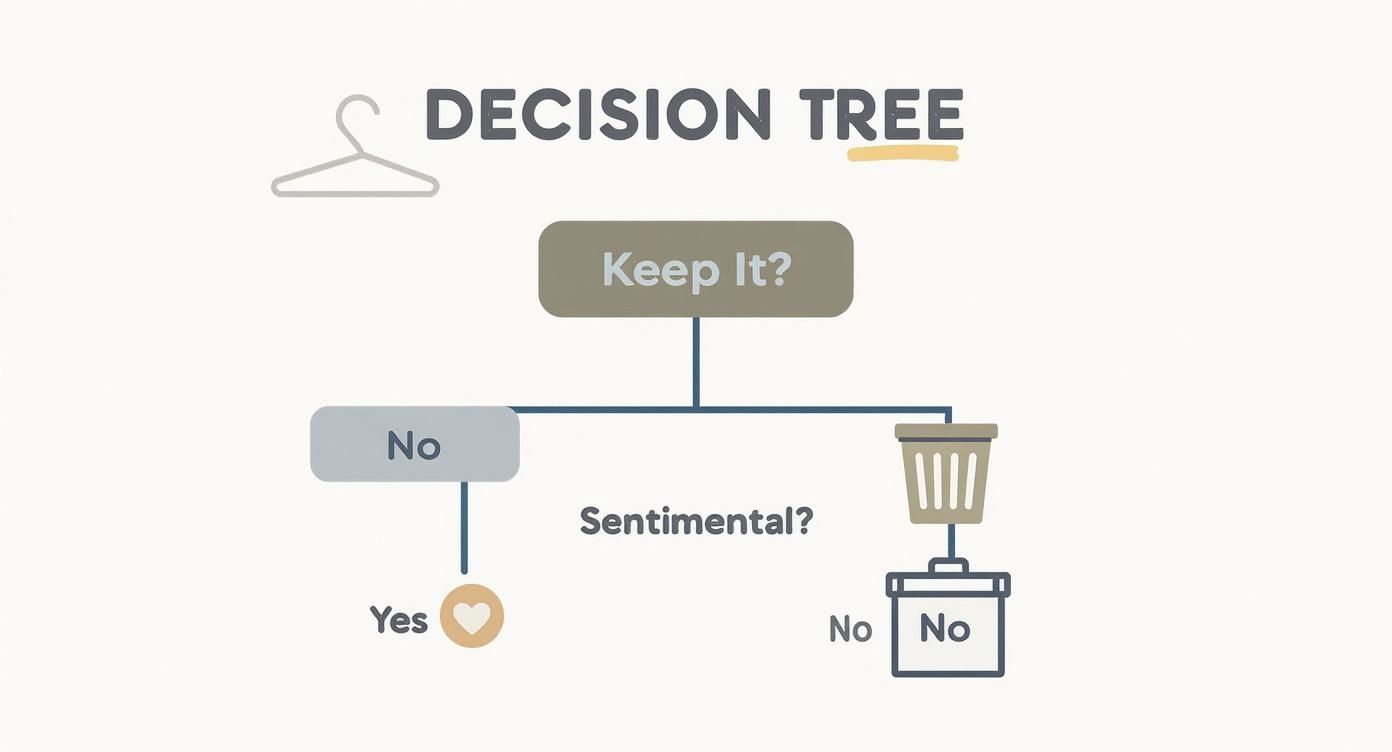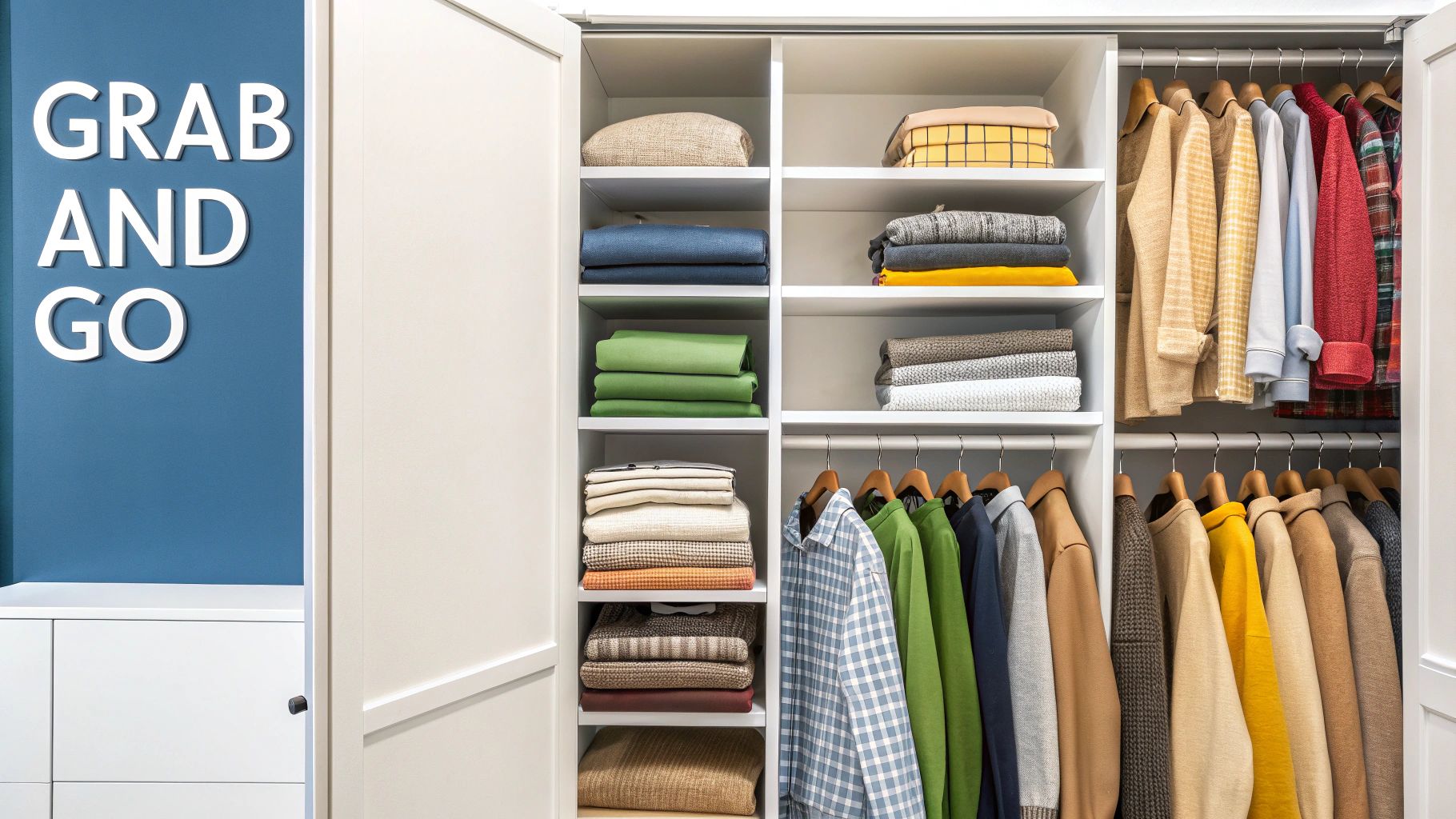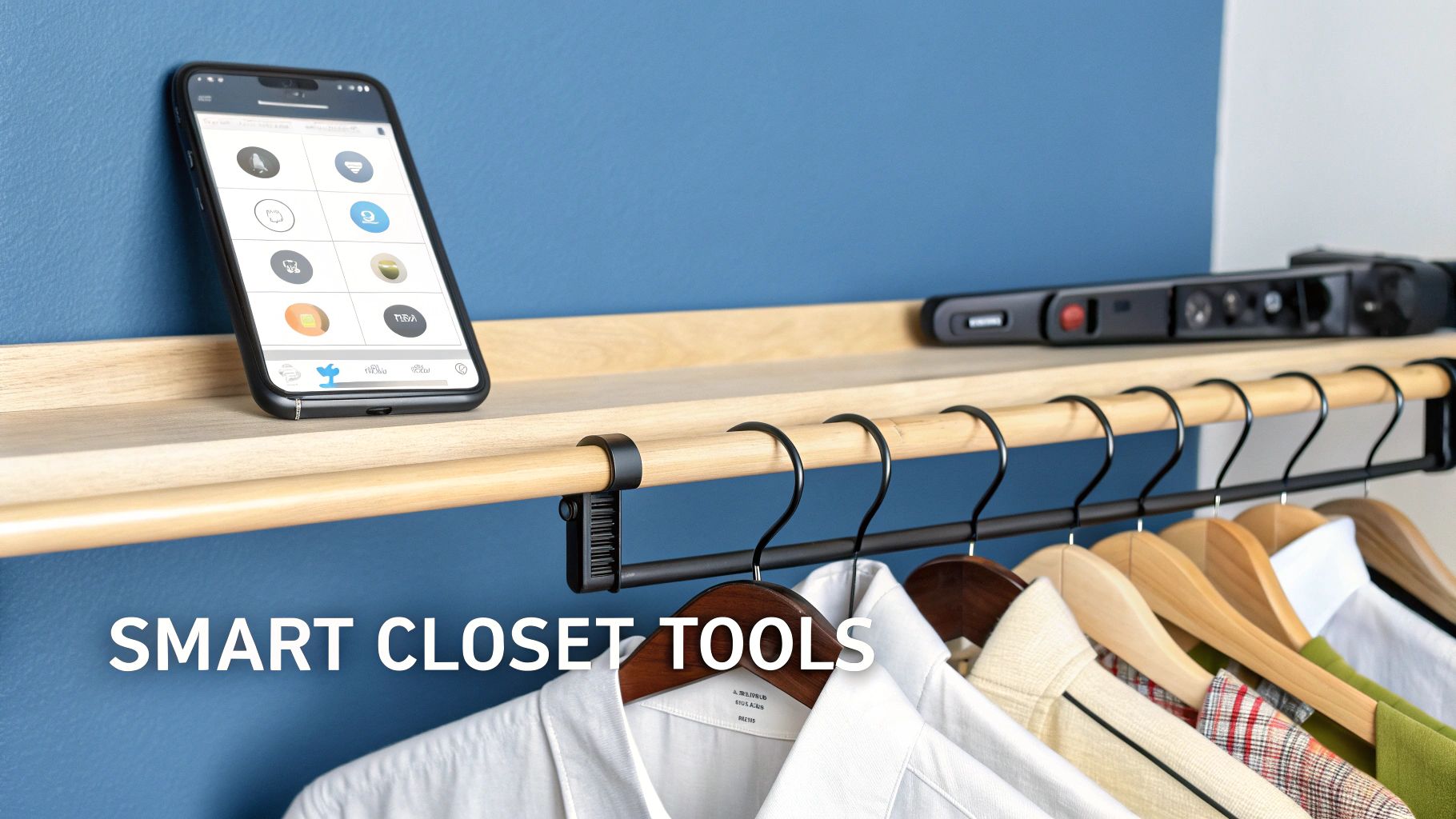Decluttering Your Wardrobe: The Ultimate Guide to Closet Organization

Let's be honest, cleaning out your closet is about so much more than just tidying up. The goal is to create a functional, organized space where you can easily find clothes you love to wear. To truly conquer the clutter, you have to create a system that works for the person you are right now.
Why Is It So Hard to Let Go of Clothes?
Opening a jam-packed closet door can feel overwhelming. It's not just a pile of fabric; it’s a tangible history of your life. Every shirt, dress, and pair of jeans can be tied to memories, goals, and even past versions of yourself. That emotional weight is what can make the decluttering process feel so impossible.
We all hang onto things for reasons that have little to do with whether we'll actually wear them again. Sound familiar?
- The Nostalgia Trap: You know the one—the dress from that amazing first date or the T-shirt from a concert you'll never forget. It feels like getting rid of the item means losing the memory, so it stays, unworn, taking up valuable closet space.
- The "Someday" Pile: This is the aspirational clutter. Those goal-weight jeans, the fancy outfit for an event you haven't been invited to yet. These clothes represent a life you imagine for yourself, not the one you’re living today.
- The Guilt Collection: We all have them. The expensive jacket you bought on impulse and never wore, or the well-meaning gift from a relative that just isn't your style. They clog up your closet because you feel too guilty to part with them.
If this sounds like you, you’re not alone. This psychological tug-of-war is a huge reason why the global closet organizer market is projected to reach $8.25 billion. With living spaces getting smaller, more of us are seeking effective closet organization solutions. You can discover more insights about wardrobe organization trends and see how others are dealing with the same challenge.
Think of decluttering as a gain, not a loss. You're not just losing old clothes; you're gaining mental clarity, physical space, and the simple joy of a well-organized wardrobe that works for your life.
A Simple Framework for Decisive Decluttering
To conquer the chaos in your closet, you need a system. The most effective way to tackle this is with a simple, no-nonsense approach often called the Four-Category Method. All you need to do is create four distinct zones or grab four boxes and label them: Keep, Donate/Sell, Store, and Discard.
The magic here is that it forces you to make a definite choice for every single item. It completely eliminates that paralyzing "maybe" pile that so often brings a decluttering session to a grinding halt. You just pick up a piece of clothing and decide which of the four piles it belongs in.
Making Confident Choices
The trick is to be really honest with yourself as you sort. For the Keep pile, don't just ask if you like it—get practical.
- Does this fit my body right now?
- Have I actually worn it in the last 12 months?
- Does it suit my current lifestyle, not the one I had five years ago?
This kind of direct questioning helps you move forward when you start feeling stuck.

As you can see, even the clothes you don’t keep get handled with intention, separating cherished memories from items that are ready for a new life elsewhere.
When it comes to the Donate/Sell box, think about what’s actually worth the effort of selling. Is it in great condition from a sought-after brand? If not, donating is a much quicker win.
The Store box should be used sparingly. This is strictly for out-of-season clothing or genuinely sentimental pieces you can’t part with but don't need in your daily closet. And the Discard pile? That’s for anything stained, torn, or damaged beyond repair.
This structured framework removes the guesswork. By giving every single item a clear destination, you can methodically work through the clutter and take back your space without all the usual hesitation.
To help you stay on track, I've put together a quick reference guide. Use this to make fast, effective decisions as you sort through your wardrobe.
Your Four-Category Decluttering Checklist
| Category | Decision Criteria | Next Action |
|---|---|---|
| Keep | Fits you now, you love it, and you've worn it recently. | Hang it back in your newly organized closet. |
| Donate/Sell | Good condition but no longer your style or fit. | Take to a local charity or list online. |
| Store | Sentimental value or out-of-season. | Pack neatly in a labeled storage bin. |
| Discard | Damaged, stained, or worn beyond repair. | Place in a bag for textile recycling or trash. |
This systematic approach is just the start. If you want to dig deeper into making these choices, you can find more decluttering clothes tips to help you refine your process.
By following this method, you're not just clearing out clothes—you're curating a functional wardrobe that actually works for you.
Organizing Your Closet for Real Life
You’ve made it through the tough part—the big declutter. Now it’s time for the fun bit: creating a closet that actually works for you and your daily routine. This isn't just about cramming everything back in neatly; it's about building a smart, intuitive system where every single item has a place. Trust me, an organized closet saves a surprising amount of time and mental energy each morning.
First things first, let's group like with like. All your tops go together, all your pants in another spot, then your dresses, skirts, and so on. Creating these simple "zones" in your closet is a game-changer. No more frantic searching through a jumble of clothes for that one specific shirt—you'll know exactly which section to head to.

From Categories to Color Coding
Ready to take it up a notch? Once your clothes are sorted by type, arrange each section by color. It sounds a little extra, but it makes a huge difference. I like to follow the rainbow (red, orange, yellow, green, blue, etc.) and then finish up with the neutrals like white, grey, brown, and black. This little trick not only looks amazing—like your own personal boutique—but it also makes putting outfits together incredibly fast.
Think about it: next time you need a simple white blouse, you can go straight to your tops section, find the white group, and see all your options in a single glance. It's a small habit that streamlines your whole morning.
An organized closet is a reflection of an organized mind. By creating a visually calm and logical space, you're not just arranging fabric—you're setting yourself up for a smoother, more intentional start to every day.
To Hang or to Fold? That Is the Question
Not everything belongs on a hanger. Knowing what to hang and what to fold is key to keeping your clothes in great shape and making the most of your closet organization.
-
Always Hang These:
- Dresses and Skirts: Hanging is the best way to prevent deep-set wrinkles and help them keep their shape.
- Blouses and Shirts: Anything made from delicate or easily creased fabric like silk, rayon, or linen definitely needs a hanger.
- Jackets and Blazers: To preserve the structure in the shoulders and collar, hanging is non-negotiable.
- Trousers: You can hang trousers by the cuff or fold them neatly over a hanger to avoid that awkward crease down the middle.
-
It's Better to Fold These:
- Sweaters and Heavy Knits: Gravity is not your friend here. Hanging heavy knits will stretch them out and can leave those dreaded shoulder bumps. Fold them and stack them on a shelf instead.
- T-shirts and Casual Tops: Your basic tees, tank tops, and activewear are perfectly happy being folded or even rolled. This frees up so much precious hanging space.
- Jeans: Denim is tough. It can be folded and stacked without losing its shape, making it an ideal candidate for shelf or drawer storage.
Putting these simple strategies into play will completely transform your closet from a source of daily stress into a functional, grab-and-go system that truly makes your life easier.
Smart Tools for Modern Closet Organization

Once you've got a good layout figured out, the right tools can take your closet from just tidy to genuinely functional. Organizing your closet today is about more than just folding sweaters and hanging shirts; it’s about being strategic. A few clever upgrades can completely change how you use the space.
For instance, one of the easiest and most effective changes is ditching your mismatched, chunky hangers for a slim, uniform set. I've seen it time and time again—this one simple swap can free up as much as 50% more rod space, almost like magic.
The Power of the Right Hanger
Think about velvet or other slim-profile hangers. They're a classic example of a small investment with a massive return. Their grippy surface means your silk tops and dresses actually stay put, and their thin design lets you hang more items without anything getting crushed.
It’s not just about cramming more in, though. Using the same style of hanger throughout your closet creates a clean, cohesive look, kind of like a high-end boutique. It’s a subtle change, but it makes your wardrobe feel way more intentional and less cluttered. If you're ready to make the switch, our guide on the best space saving hangers can help you find the perfect match for your clothes. You can find it right here: https://moralve.com/blogs/news/best-space-saving-hangers
The goal isn't just to store your clothes, but to make them easily accessible and well-cared for. Smart tools are the bridge between a decluttered closet and a truly functional wardrobe.
Digital Tools for a Smarter Wardrobe
Organization is also going digital. There are some fantastic apps out there that let you create a virtual catalog of everything you own. You can use them to plan outfits without pulling everything out, see what you haven't worn in a while, and even prevent buying a duplicate of that black t-shirt you already have three of.
This tech-forward approach is becoming more common. The smart wardrobe market hit $127.6 million and is still growing, fueled by our desire for more convenient, AI-driven ways to manage our clothes. By exploring the smart wardrobe market trends, you can see just how much technology is beginning to shape even our closets. Using an app is a great way to get more creative with the pieces you already have and make more informed shopping decisions.
How to Keep Your Wardrobe Clutter-Free
https://www.youtube.com/embed/UQHYR1M0tpg
Getting your closet organized feels fantastic, doesn't it? But the real test is keeping it that way. If you don't build a few good habits, the clutter has a sneaky way of creeping back in. The trick is to stop thinking of closet organization as a one-time project and start seeing it as an ongoing, mindful practice.
One of the most effective habits I've ever adopted is the 'One-In, One-Out' policy. It’s as simple as it sounds: every time you bring a new piece of clothing home, an old one has to go. This simple rule forces your closet into a state of equilibrium and stops the slow, steady pile-up of stuff you never wear. It also makes you a much more conscious shopper—you start asking if that new sweater is really worth giving up one you already have.
This kind of intentional living is becoming more common. In fact, the global market for home organization products has already hit $13.27 billion and is expected to keep growing as more people look to create calm, orderly homes. You can even see the full research on the home organization market trends to understand how big this movement is.
Make a Seasonal Closet Audit Your New Ritual
Another great strategy is to perform a quick seasonal "closet audit." You don't need to do a massive, weekend-long declutter. Just take a few moments to reassess things as you swap your warm-weather clothes for your cold-weather ones (and vice-versa).
It’s just a quick check-in. Ask yourself a few simple questions about each item you're putting away:
- Did I even wear this last season?
- Is it still in good shape? Does it still fit right?
- Does this piece still feel like "me" and fit my lifestyle?
This little review helps you spot clutter before it gets comfortable and settles in for another year. It also makes the seasonal switch-up feel so much easier because you know you’re only storing clothes you actually love and plan to wear again.
By turning these small, consistent actions into routines, you transform decluttering from a dreaded chore into a simple part of maintaining a functional and inspiring wardrobe.
And don't forget that how you store your off-season clothes matters, too. Don't just shove them to the back of the closet. Use proper storage bins, and for those bulky sweaters and jeans, learning a few folding tricks can be a game-changer. We've got a whole guide on folding clothes to save space that shows you exactly how to do it.
Still Have Questions? Let’s Clear Things Up
Even with the best intentions, the process of decluttering and organizing your closet can feel a bit overwhelming. It’s totally normal to hit a roadblock or have questions pop up along the way. Getting past these hurdles is what separates a cluttered-again-in-a-week closet from one that actually stays organized. Let's tackle some of the most common questions I hear.
So, where do you even begin when you can barely see the floor? My go-to advice is always the same: take absolutely everything out. Yes, everything. It sounds drastic, but creating a completely blank slate is the only way to be truly intentional about what goes back in. Otherwise, you’re just shifting piles around.
How Often Should I Really Be Doing This?
For a full-blown, deep declutter and reorganization, aim for once or twice a year. The shift in seasons is a perfect natural reminder. It's the ideal time to take stock of what you actually wore over the last six months versus what just took up space.
To keep things from getting out of hand again, try a quick 15-minute closet check-in once a month. This little habit helps you spot things you've fallen out of love with before they become part of a bigger clutter problem. It also makes those big seasonal sessions way less daunting.
Think of decluttering less like a massive annual purge and more like a simple, ongoing conversation with your wardrobe. It’s these small, consistent edits that keep your space feeling calm and organized.
What Do I Do With Sentimental Clothes?
This is probably the toughest part for everyone. We all have those items that are tied to a powerful memory, but letting them clog up your daily wardrobe isn't doing you any favors. The trick is to separate the memory from the physical object. Does that concert t-shirt from a decade ago really need to be in your active closet?
If you can’t bring yourself to toss it, don’t! Just give it a new home. Create a dedicated memory box.
- Be selective and choose only the most meaningful pieces.
- Store them safely somewhere other than your closet.
This way, you get to honor the sentiment without sacrificing precious closet real estate. You’re keeping the memory, not the clutter, and making space for the person you are today.
Ready to create a closet that stays organized for good? MORALVE's space-saving hangers are designed to maximize your space and keep your curated wardrobe looking its best. Explore our innovative closet solutions today!


Leave a comment